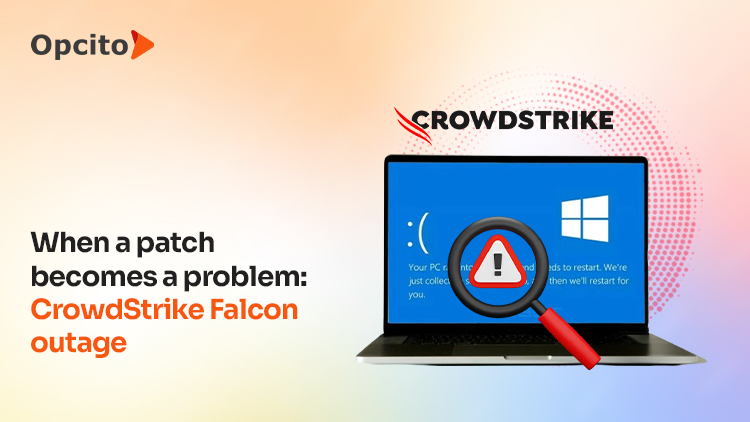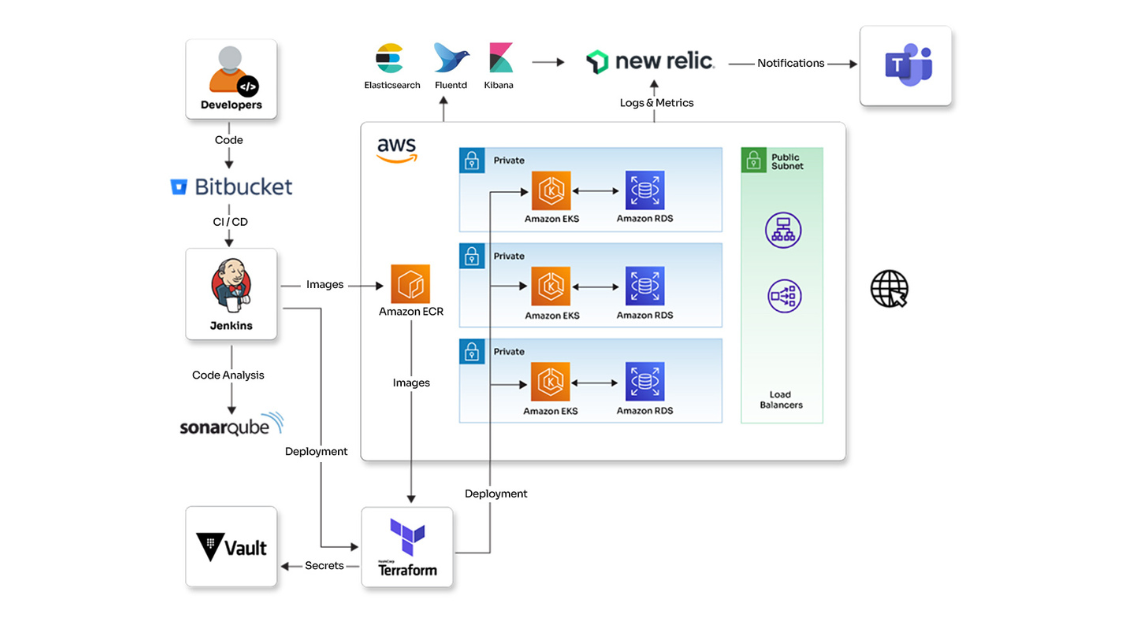Securing multi-cloud configuration
Multiple organizations are now using multi-cloud strategies to make their IT systems more efficient, reduce costs, and improve overall productivity. As they shift their workloads and applications to multiple cloud providers, ensuring the security of these environments becomes a top concern. Embracing a multi-cloud approach comes with its unique challenges and security considerations. This involves safeguarding an organization's data, applications, and infrastructure across various cloud settings, including public, private, and hybrid clouds. It's like managing different puzzle pieces with their own rules.
To tackle these challenges, organizations need to understand the diverse policies, standards, and technologies of each cloud provider and must navigate this complex landscape carefully. By doing so, they can enjoy the benefits of multi-cloud while keeping their digital assets secure. This evolving multi-cloud trend offers promise and complexity, making it crucial for organizations to find the right balance between efficiency and security while configuring their multi-cloud solutions. This blog aims to help organizations get their multi-cloud game spot on by explaining the best practices that help these complex cloud environments not just survive security incidents but thrive in a highly insecure space where threats are just around the corner.
What is multi-cloud security?
Multi-cloud security is highly essential in today's cloud computing landscape, and businesses are increasingly adopting multi-cloud architectures to harness diverse cloud provider benefits, thus leading to greater complexity in securing these ecosystems. The multi-cloud security approach involves a comprehensive framework that includes policies, procedures, and technologies to protect data, applications, and infrastructure across multiple cloud service providers, ensuring resource confidentiality, integrity, availability, and regulatory compliance.
Recognizing that each cloud provider has unique security controls and compliance requirements, a comprehensive strategy is essential while configuring multi-cloud environments. This approach encompasses identifying and mitigating platform-specific risks, integrating security tools, and establishing clear security policies for access management, data protection, and incident response across all platforms. While multi-cloud integration offer flexibility, cost management, and resiliency, they also increase the potential for cyber threats, necessitating a holistic security approach to address vulnerabilities and maintain consistent controls across diverse cloud environments.
Multi-cloud security challenges
Multi-cloud environments do offer numerous benefits, but configuring and operating in diverse, interoperable settings comes with specific challenges and a set of obstacles. Below are the significant typical challenges that arise while configuring multi-cloud security:
- Skills and expertise gap: Managing multi-cloud security requires specialized skills and expertise to navigate the diverse cloud ecosystems and ensure robust security measures are in place.
- Cross-platform integration: Integrating multiple cloud platforms can be complex due to variations in technologies and APIs used by different vendors, making it challenging to establish seamless security protocols.
- Expanded attack surface: Incorporating multiple cloud vendors expands the attack surface, making comprehensive security measures necessary to protect against potential threats from various entry points.
- Latency and reliability: Transferring data between different cloud platforms can introduce latency issues that affect performance and reliability, impacting the overall security posture.
- Unified governance: The absence of a unified governance framework complicates the management of security policies, access control, and monitoring across multiple cloud environments, leading to potential security gaps.
- Inconsistencies and silos: Inconsistencies in security policies may emerge due to staffing gaps and training silos, increasing exposure to cyber threats, and hampering effective responses to security incidents.
- Interoperability issues: Varying APIs and protocols used by different cloud providers can result in interoperability challenges, potentially hindering the consistent enforcement of security policies.
- Visibility and monitoring: Detecting security incidents across all cloud environments can be challenging without proper monitoring and visibility tools, potentially resulting in delayed responses and increased damage.
Multi-cloud security best practices
Let’s take a detailed look at the best practices for a secure multi-cloud setup.
Identity Access Management (IAM)
IAM, also Identity Access Management or Identity & Access Management, is a vital component of multi-cloud security. It involves the policies, procedures, and technologies that enable organizations to manage, authenticate, and authorize access to their cloud resources. In a multi-cloud environment, managing user identities, roles, and permissions across various cloud platforms gets complex. Each cloud provider has its unique IAM system and security measures. To address this complexity, it's essential to create granular IAM policies for each provider to enforce the least privilege.
To establish a robust Identity and Access Management (IAM) framework, it's advisable to follow some essential practices. One critical practice is implementing multi-factor authentication (MFA), which enhances security by necessitating multiple forms of identification before granting access to cloud resources. Additionally, conducting regular audits is crucial to continuously monitor and review IAM policies and user activities across all cloud providers, allowing for the identification and mitigation of potential security risks. These practices are essential steps in maintaining a secure and efficient IAM framework.
Data security
Protecting sensitive data within multi-cloud environments is a critical priority. To achieve this, first, employ data loss prevention (DLP) tools, which can effectively identify and safeguard sensitive data by enforcing data handling policies and offering insight into data usage. Also, ensure that all your cloud providers support industry-standard encryption protocols for data in transit and at rest. Lastly, regularly review and update data access policies to detect and address discrepancies and potential security threats. By implementing these measures, you can significantly enhance your data security posture in multi-cloud environments.
Compliance and governance
Maintaining compliance and governance in multi-cloud environments, particularly concerning regulations like GDPR, HIPAA, and PCI DSS, is paramount to avoid potential fines and legal consequences. To establish a robust framework for compliance, begin by implementing comprehensive policies and procedures that cover data handling, storage, and compliance requirements for each cloud provider. Careful selection of cloud providers that align with your organization's specific regulatory needs is essential to minimize compliance gaps. It is crucial to prioritize visibility. Continuous monitoring solutions play a pivotal role in achieving this. These tools offer real-time monitoring capabilities, swiftly detecting potential security breaches and non-compliance issues. Adopting a proactive approach to identify and rectify misconfigurations across the multi-cloud environments helps reduce the attack surface and strengthens the overall security posture. By following these practices, you can navigate the complex landscape of multi-cloud compliance and governance with confidence and effectiveness.
Business continuity and disaster recovery (BCDR)
To ensure business continuity and disaster recovery (BCDR) across multi-cloud environments in unforeseen times, a well-structured plan is essential. Firstly, diversify your backup strategy by storing backups across multiple cloud providers. This approach minimizes the risk of data loss resulting from provider-specific issues. Maintaining consistent backup policies across various providers is also crucial. Uniform backup policies help with seamless data recovery during disasters.
Furthermore, to enhance the reliability of your BCDR strategy, regularly test and simulate disaster scenarios. This testing ensures the effectiveness of your disaster recovery plan and helps in identifying and addressing any potential vulnerabilities. By following these practices, you can confidently overcome the complexities of business continuity and disaster recovery in multi-cloud environments, ultimately safeguarding your critical data and operations.
Network security
A systematic approach is necessary to enhance network security within multi-cloud environments. Start by implementing network segmentation by dividing your network into isolated segments to restrict unauthorized access. This step will bolster the overall security by compartmentalizing network resources. Simultaneously, ongoing monitoring and management of network traffic play a pivotal role in safeguarding networks. Utilize monitoring tools and intrusion detection systems to proactively identify suspicious activities in real-time, for swift threat detection and response.
Additionally, it's essential to focus on securing network connections between various cloud environments. Employ encryption protocols for data transmitted between these environments to add an extra layer of protection, safeguarding sensitive information during transit. These practices collectively contribute to a robust network security posture in multi-cloud settings, assuring the integrity and confidentiality of your data and network resources. Implementing these network security best practices will enable organizations to enhance multi-cloud environment security effectively.
Summarizing the baseline for multi-cloud configuration
- Always opt for multi-factor authentication (MFA).
- Conduct regular audits of IAM policies and user activities.
- Utilize data loss prevention (DLP) tools to identify and protect sensitive data.
- Ensure industry-standard encryption protocols for data in transit and at rest.
- Consistently review and update data access policies.
- Carefully select cloud providers that align with your organization's regulatory needs.
- Implement comprehensive policies and procedures covering data handling and compliance requirements for each cloud provider.
- Leverage continuous monitoring solutions for real-time visibility into security breaches and non-compliance issues.
- Adopt a proactive approach to identify and rectify misconfigurations, reducing the attack surface and strengthening overall security.
Modern-day cloud computing demands multi-cloud security capabilities, and you need a strong security plan that deals with the different multi-cloud challenges. These best practices will help you ensure the safety, integrity, confidentiality, and availability of multi-cloud resources, while being compliant with the necessary regulatory demands. Opcito is a seasoned expert in configuring and managing cloud environments and is trusted by some big names. Get in touch with us at contact@opcito.com to secure your multi-cloud environment.













